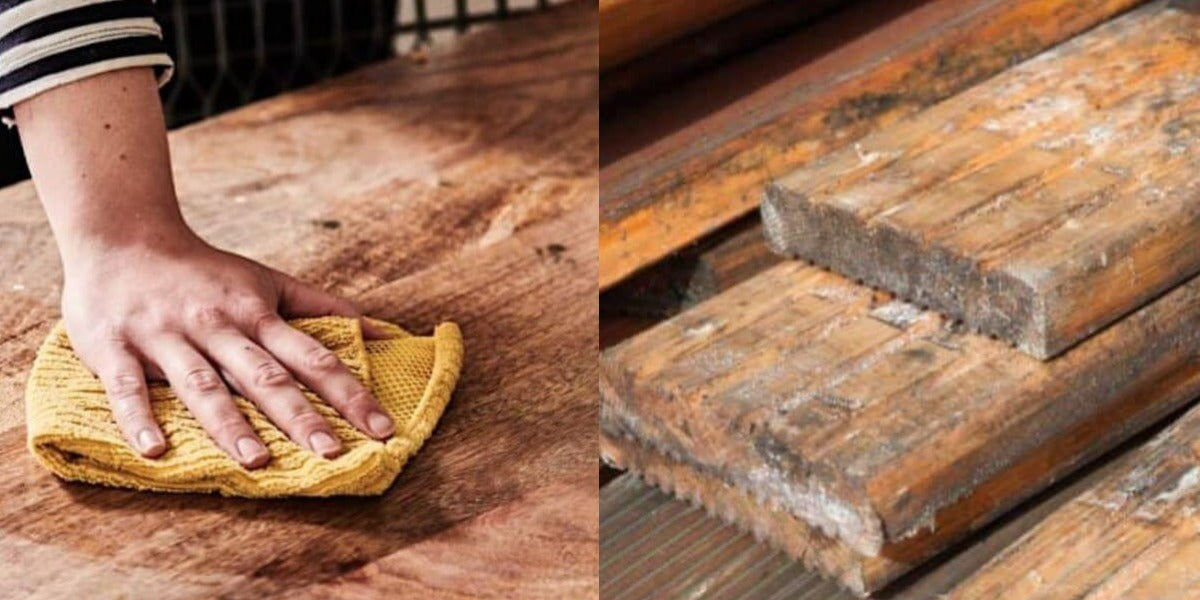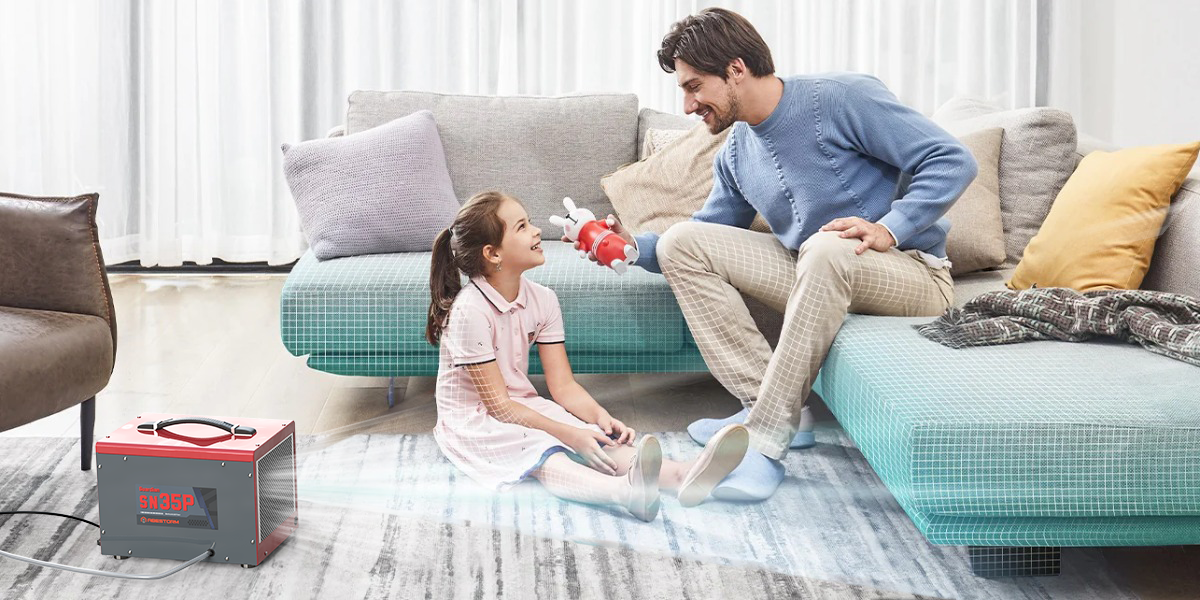What’s disheartening for a homeowner is watching colonies of mold growth on his wooden furniture or wood ceilings. Don’t worry you’re not a neat freak, if you don’t like this ugly sight. Nobody stands mold growth in his house. Mold on wood is a common problem that many homeowners face, particularly in areas with high humidity. Not only does mold damage the wood, but it also poses serious health risks, such as respiratory issues and allergic reactions. Add Abestorm Filteair HEPA V3 Air Scrubber into your toolkit to prevent mold without lifting a finger.
Understanding how to treat mould on wood is crucial for maintaining a healthy living environment. In this guide, we'll walk you through the steps to effectively remove mold from wood, provide tips on preventing its return, and recommend the best products for mold treatment. Whether you're dealing with mold on furniture or structural wood, this guide has you covered.
Understanding Mold on Wood
How to treat mold on wood is a burning question nowadays not because it’s unsightly. It’s because it poses serious health and structural risks to a house. Therefore, getting into the nitty gritty of mold treatment for wood; identifying different types of mold and its common signs is really crucial. This step is the cornerstone of cleaning up mold on wood.
Types of Mold That Can Appear on Wood
There are several types of mold that can grow on wood, each with varying degrees of danger:
- Aspergillus: Often found in damp areas, this mold can cause allergic reactions and respiratory issues.
- Penicillium: Known for its blue or green appearance, it can cause allergies and asthma.
- Stachybotrys chartarum (Black Mold):This toxic mold is black and can cause severe respiratory problems and other health issues.
Mold not only damages the structural integrity of the wood but also poses significant health risks to occupants.
Dr. Jane Smith, a mold remediation expert, emphasizes,
"Addressing mold growth on wood promptly is crucial to prevent structural damage and health issues. Early detection and proper treatment are key."
Common Signs of Mold on Wood
Recognizing the early signs of mold on wood can help you address the problem before it becomes severe. Common indicators include:
- Discoloration:Black, green, or white spots on the wood surface.
- Musty Odor:A persistent, musty smell in the area where the mold is growing.
- Warping: Wood that is warped or has a spongy texture may have mold growth beneath the surface.
- Allergic Reactions:Increased allergy symptoms among residents, such as sneezing, coughing, and itchy eyes.

Preparing for Mold Treatment
Before you begin treating mold on wood, it’s important to gather the necessary materials and take proper safety precautions. Here’s what you need to get started for mold treatment for wood:
Materials and Tools Needed
- Protective gloves
- Safety goggles
- N95 mask or respirator
- HEPA air scrubber
- Plastic sheeting
- Tape
- Soft-bristle brush
- Non-ammonia soap or detergent
- Water
- White vinegar or hydrogen peroxide
- Commercial mold cleaner (best mold killer for wood)
- Clean cloths
- Sandpaper (for severe mold cases)
Safety Precautions
Mold treatment can expose you to harmful spores, so it's crucial to protect yourself and contain the mold. Before starting cleaning up mold on wood remember a few things. Open windows and use fans to ventilate the area where you’ll be working. A HEPA air scrubber can help filter out mold spores and improve air quality during the cleaning process. Always wear gloves, safety goggles, and an N95 mask or respirator to protect yourself from mold spores. Use plastic sheeting and tape to seal off the affected area from the rest of your home to prevent mold spores from spreading.
“Mold spores can be hazardous to your health, especially during the cleaning process. Always use proper protective equipment and isolate the affected area to minimize exposure,” advises Dr. Jane Smith, a mold remediation expert.
How to Treat Mould on Wood
Removing mold from wood involves several steps to ensure thorough cleaning and prevention of future growth. Here’s a detailed guide on how to treat mold on wood:
Step-by-Step Instructions
- Identify the Affected Areas: Carefully inspect the wood surfaces to identify all areas with mold growth. Look for discoloration, musty odors, and signs of warping.
- Ventilate the Area: Ensure proper ventilation by opening windows and using fans. Set up a HEPA air scrubber to improve air quality and capture airborne mold spores.
- Wear Protective Gear: Put on gloves, safety goggles, and an N95 mask or respirator to protect yourself from mold exposure.
- Apply the Best Mold Killer for Wood: For mild mold, mix non-ammonia soap or detergent with water. For more severe mold, use a commercial mold cleaner specifically designed for wood. You can also use natural cleaners like white vinegar or hydrogen peroxide.
- Scrub the Mold Off the Wood Surface: Dip a soft-bristle brush into the cleaning solution and scrub the moldy areas gently. Be thorough to ensure you remove all visible mold. For stubborn mold, sand the affected area lightly with sandpaper.
- Rinse and Dry the Wood Thoroughly: Wipe the cleaned areas with a damp cloth to remove any remaining cleaner and mold residue. Dry the wood completely to prevent moisture from lingering, as dampness can encourage mold regrowth.
Using HEPA Air Scrubbers
HEPA air scrubbers are highly effective in improving air quality during and after the mold removal process. These devices filter out mold spores, reducing the risk of mold spreading to other areas of your home.
How to Clean Mold Wood Furniture
Mold can easily find its way onto wood furniture, especially in humid environments. Here’s how to remove mold from wood furniture effectively:
Move Furniture Outside
If possible, move the affected furniture outside to prevent mold spores from spreading inside your home. If this isn’t feasible, ensure the area is well-ventilated and isolated to contain the spores.
Vacuum the Furniture
Use a vacuum cleaner with a HEPA filter to remove loose mold spores from the surface. This step is crucial to prevent the spores from spreading. Dispose of the vacuum bag or clean the canister immediately after use to ensure mold spores do not escape back into the environment.
Prepare a Cleaning Solution
Mix a solution of non-ammonia soap or detergent with water. For tougher mold, use white vinegar, hydrogen peroxide, or a commercial mold cleaner specifically designed for wood. These solutions are effective in breaking down mold spores.
Scrub the Affected Areas
Dip a soft-bristle brush into the cleaning solution and gently scrub the moldy areas. Be careful not to damage the wood surface. This step might require some elbow grease, but it is essential for removing all traces of mold.
Rinse and Dry
After scrubbing, wipe the cleaned areas with a damp cloth to remove any remaining cleaner and mold residue. Dry the furniture thoroughly with a dry cloth or let it air dry in a well-ventilated area. Ensuring the wood is completely dry is crucial to prevent mold from reappearing.
Apply a Protective Finish
Consider applying a protective finish or sealant to the cleaned wood furniture. This helps to prevent future mold growth by creating a barrier that moisture cannot penetrate as easily.
These steps are your comprehensive answer to how to clean mold wood furniture.
Preventing Mold on Wood Furniture
Control Humidity
Using a dehumidifier to maintain indoor humidity levels between 30-50% significantly reduces the risk of mold growth. Consistent humidity control is essential for a mold-free environment.
Proper Ventilation
Ensure good airflow in rooms with wood furniture, especially during humid weather. Proper ventilation helps to keep moisture levels low and prevents mold spores from settling and growing.
Regular Cleaning
Dust and clean wood furniture regularly. This prevents mold spores from finding a place to settle and grow, maintaining a healthy indoor environment.
Best Mold Killer for Wood
Use commercial mold cleaners specifically designed for wood surfaces. These products are formulated to penetrate wood and kill mold spores effectively, ensuring thorough cleaning and prevention.
Natural Solutions
White vinegar and hydrogen peroxide are effective natural cleaners for treating mold on wood. They can be used as safer alternatives to chemical cleaners, offering an environmentally friendly option for mold removal.
Conclusion
Treating and preventing mold on wood is essential for maintaining a healthy living environment. By understanding how to treat mold on wood, using the right products, and implementing long-term prevention strategies, you can keep your home safe and mold-free. Regular maintenance and prompt treatment are key to protecting both your health and your property. HEPA air scrubber is the key to keeping the air of your house clean so you don’t have to type in the search bar how to remove mold from wood ever again.
Ready to tackle mold on wood effectively?
Visit Abestorm.com to explore our range of products, including the HEPA Air Scrubber, designed to aid in mold removal and improve indoor air quality. For a limited time, enjoy promotional discounts and expert advice on keeping your home mold-free. Invest in a healthier living environment today!









Shop For Dehumidifier